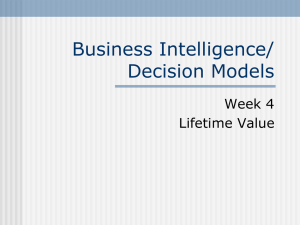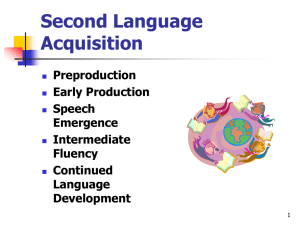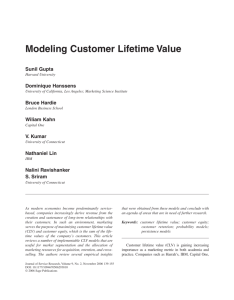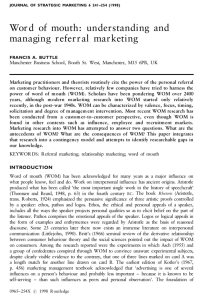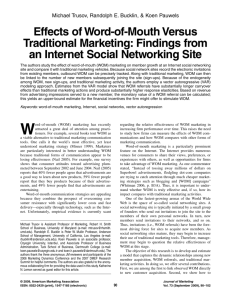Analytics for Customer Engagement
advertisement
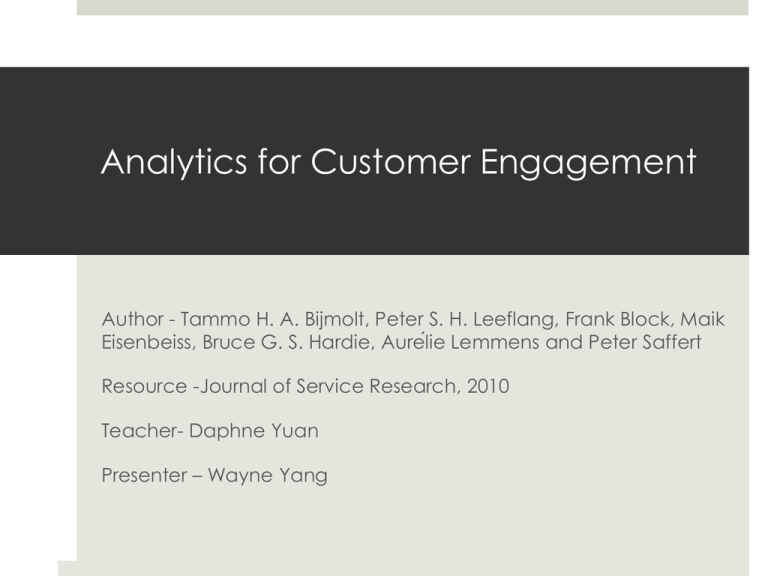
Analytics for Customer Engagement Author - Tammo H. A. Bijmolt, Peter S. H. Leeflang, Frank Block, Maik Eisenbeiss, Bruce G. S. Hardie, Aurélie Lemmens and Peter Saffert Resource -Journal of Service Research, 2010 Teacher- Daphne Yuan Presenter – Wayne Yang Agenda Background Info Scope Big Data Analysis Models for Customer Engagement Models for Customer Acquisition Models for Customer Development Models of Customer Retention Barriers for Implementation in Practice Conclusion 1 Background Info A different perspective is now emerging, namely, that customers can cocreate value, cocreate competitive strategy, collaborate in the firm’s innovation process, and become endogenous to the firm. we distinguish between three general manifestations of customer engagement: WOM, customer cocreation, and complaining behavior; all of which affecting the brand or firm in ways other than purchase. 2 Background Info Customer engagement is connected to customer value management (Verhoef, van Doorn, and Dorotic 2007) through its objective, namely, to maximize the value of a firm’s customer base. . For example, von Wangenheim and Bayon (2007) find that the lack to incorporate WOM in the customer lifetime value (CLV) calculation could lead to an underestimation of the CLV by up to 40%. 3 Scope 1. To review opportunities and organizational aspects with respect to data collection for customer engagement; 2. To give a brief overview of ‘‘traditional’’ models dealing with customer transactions and to subsequently discuss how key behavioral manifestations of customer engagement (WOM, cocreation, and complaining behavior) can be included in these models; 3. To discuss problems that are apparent in marketing practice and constitute barriers for introducing analytics for customer engagement. 4 Big Data Analysis As illustrated in Figure (a), the standard model building process starts with the management problem being studied. The model builder develops his model and applies it to data using his standard suite of modelling tools. However, the custom programs, specialist modelling environment and complex data structures serve as barriers to implementation in the firm. 5 Big Data Analysis In sharp contrast, the process of building a ‘simple model’ considers the modelling environment and data management constraints at the beginning, and these help guide the development of the formal model, as illustrated in Figure 3(b). 6 Models for Customer Engagement -Models for Customer Acquisition The initial goal of customer acquisition is to select the ‘‘right’’ prospects for the acquisition campaign. Once the decision regarding which customers to focus on has occurred, the next question to be addressed is how to allocate resources among marketing variables for leveraging customer acquisition. Scoring models ex: RFM, CHAID Probability models 7 Models for Customer Engagement -Models for Customer Acquisition : RFM Recency - How recently did the customer purchase? Frequency - How often do they purchase? Monetary Value - How much do they spend? 8 Models for Customer Engagement -Models for Customer Acquisition The initial goal of customer acquisition is to select the ‘‘right’’ prospects for the acquisition campaign. Once the decision regarding which customers to focus on has occurred, the next question to be addressed is how to allocate resources among marketing variables for leveraging customer acquisition. Scoring models ex: RFM, CHAID Probability models 9 Models for Customer Engagement -Models for Customer Acquisition : CHAID 10 Models for Customer Engagement -Models for Customer Acquisition : The downside of Scoring Model 1.scoring models predict behavior in the next period only. However, estimating CLV for example not only requires information from the next period but also from periods thereafter 2. at least two data sets are required for estimation and validation. When the same data are used for model calibration as for model validation and comparison, it is possible that the model explains noise instead of the underlying relationship, a problem known as overfitting. 11 Models for Customer Engagement -Models for Customer Acquisition : Probability model 1.Probability models overcomes many of these limitations consists of probability models 2The key underlying idea of the probability modeling approach is that observed behavior is a function of an individual’s latent behavioral characteristics. After fitting a probability model to the data, inferences about an individual’s latent characteristics can be made, given his observed behavior, which, in turn, can be used for predicting future behavior 12 Models for Customer Engagement -Future Models for Customer Acquisition In the context of customer engagement, these rather purchase-related objectives can readily be replaced by behavioral manifestations other than purchase and be included in the ‘‘traditional’’ modeling approaches. For example, instead of predicting future purchase levels, analytical models may be aligned to predict the number of WOM referrals. 13 Models for Customer Engagement -Future Models for Customer Acquisition : WOM (MANAGING CUSTOMER-INITIATED CONTACTS:THE IMPACT ON SHARE OF CATEGORY REQUIREMENTS AND WORD-OF-MOUTH BEHA VIOR) Right censored – above certain value Truncated-at-zero – above one First, using a logistic regression model, they determine whether a WOM referral is made. Then, applying a truncated- at-zero NBD model, they estimate the actual number of referrals, given that at least one referral was made. 14 Models for Customer Engagement -Future Models for Customer Acquisition : WOM (MANAGING CUSTOMER-INITIATED CONTACTS:THE IMPACT ON SHARE OF CATEGORY REQUIREMENTS AND WORD-OF-MOUTH BEHA VIOR) 15 Models for Customer Engagement -Future Models for Customer Acquisition : WOM (MANAGING CUSTOMER-INITIATED CONTACTS:THE IMPACT ON SHARE OF CATEGORY REQUIREMENTS AND WORD-OF-MOUTH BEHA VIOR) 16 Models for Customer Engagement -Future Models for Customer Acquisition : WOM (MANAGING CUSTOMER-INITIATED CONTACTS:THE IMPACT ON SHARE OF CATEGORY REQUIREMENTS AND WORD-OF-MOUTH BEHA VIOR) 17 Models for Customer Engagement -Models for Customer Development In the development stage, a CLV can be stimulated through many marketing activities. For example, instead of predicting future purchase levels, analytical models may be aligned to predict the number of WOM referrals. One class of models tries to predict a consumer’s margin directly using econometric methods. For example, Venkatesan and Kumar (2004) use a regression model based on past transactions and marketing mix variables to predict the contribution margin. Another class of models investigates cross-selling (e.g., Kamakura 2008). 18 Models for Customer Engagement -Models for Customer Development Other approaches to cross- selling comprise recommendation systems. Bodapati (2008) uses a hierarchical Bayes method with a dual latent class structure to develop a model for firms’ recommendations to customers. Netzer, Lattin, and Srinivasan (2008) propose a hidden Markov model for the transitions among latent relationship states and its effects on buying behavior. The model is intended to guide the firm’s marketing decisions to alter the long-term buying behavior of its customers. 19 Models for Customer Engagement -Models for Customer Development : HMM 20 Models for Customer Engagement -Future Models for Customer Development Goldenberg et al employ a VAR modeling approach. They find that WOM-elasticities are approximately 20 times higher than that of marketing events and 10 times that of media appearances. Brand communities can create value among networked firm-facing actors, as such, the active management and stimulation to cocreate is another important task. Ex: LEGO robotistics 21 Models for Customer Engagement -Future Models for Customer Development The degree by which cocreation actually translates into CLV strongly depends on the trade-off between the costs for a firm to stimulate consumer participation (e.g., financial rewards) and the benefits that firms receive (Hoyer et al. 2010). A further manifestation of customer engagement, which is likely to affect CLV are customer complaints. 22 Models for Customer Engagement - Models for Customer Retention Customer retention is the third building block of a customer engagement strategy. A further manifestation of customer engagement, which is likely to affect CLV are customer complaints. Customer retention focuses on preventing customer attrition or churn, that is, the termination of the contractual or noncontractual relationship between the customer and the company. 23 Models for Customer Engagement - Models for Customer Retention In a noncontractual setting, the challenge is to infer whether a customer is still active or not. Most models that have been developed to assess the probability that a customer is still alive are probability models, such as the Pareto/NBD model. Recent developments in the field of machine learning, including neural networks (Hung, Yen, and Wang, 2006), support-vector machine 24 Models for Customer Engagement - Future Models for Customer Retention Numerous tracks for future research open up to researchers interested in linking customer retention decisions with customer engagement. A promising research area to account for customer engagement in the context of retention is to incorporate the potential interactions across customers in churn prediction models. Ex: eBay buyers and sellers In another direction, retention models would also benefit from accounting for heterogeneity in customer engagement across the customer base. Customers are likely to show different levels of engagement to the firm. 25 Barriers for Implementation in Practice Barrier 1: Data Quality, Size of Databases, and New Types of Data Barrier 2: Data Ownership Barrier 3: Complexity of the Models Barrier 4: Ownership of the Modeling Tools Barrier 5: Usability of the Results Barrier 6: Integration in Company Processes 26 Conclusion We have discussed analytical models for customer engagement, which goes beyond models for customer transactions. several organizational issues of analytics for customer engagement remain, which constitute barriers for implement- ing analytics for customer engagement. 27 Q&A 28 AeSL, Ambient e-Service Lab Please visit our website: http://www.aesl.nccu.edu.t w Research Topics: SOA & SSME (service science) 64, Sec. 2,Zhi-nan Rd., Wenshan, Taipei 116, Taiwan, Republic of China,Commerce Building 5F






